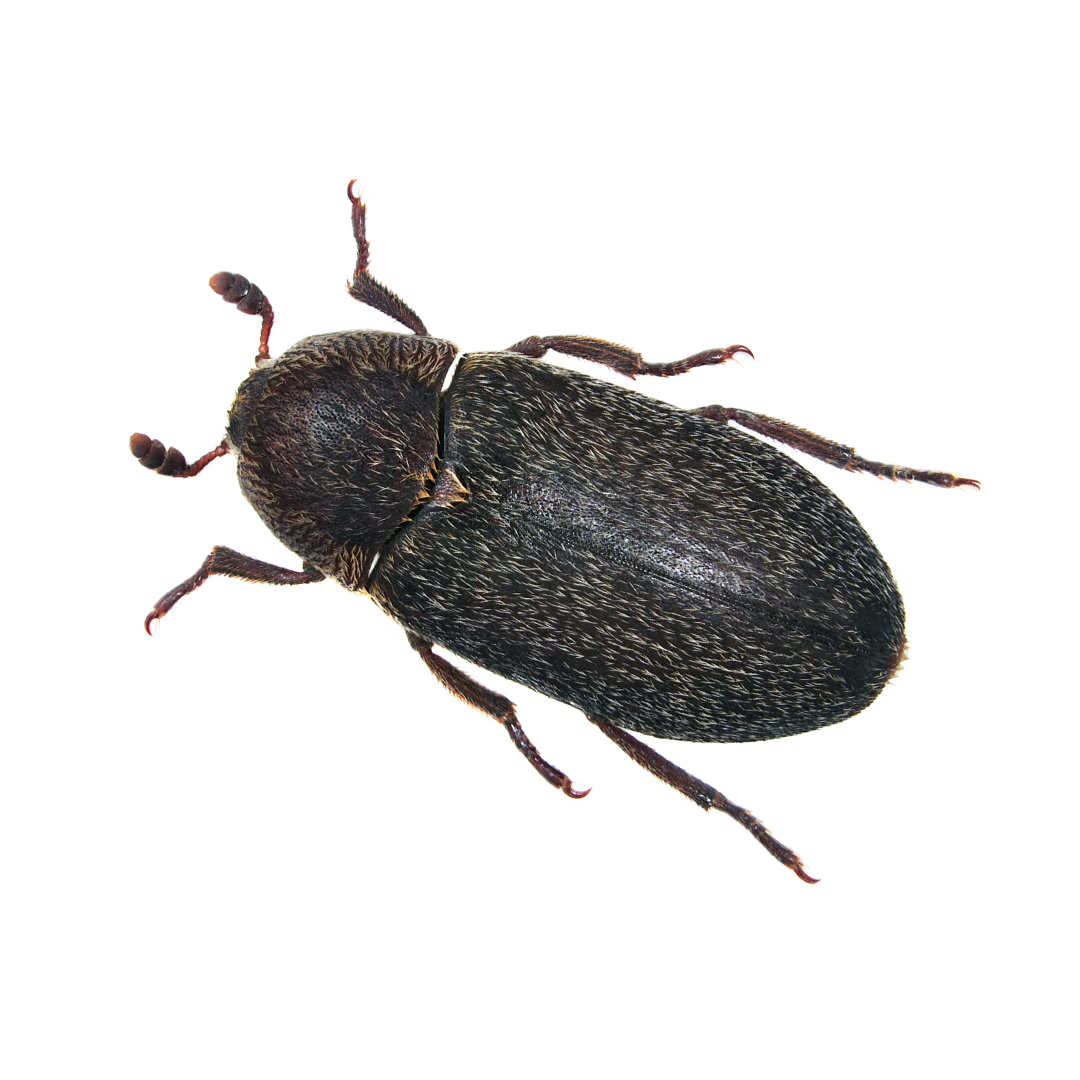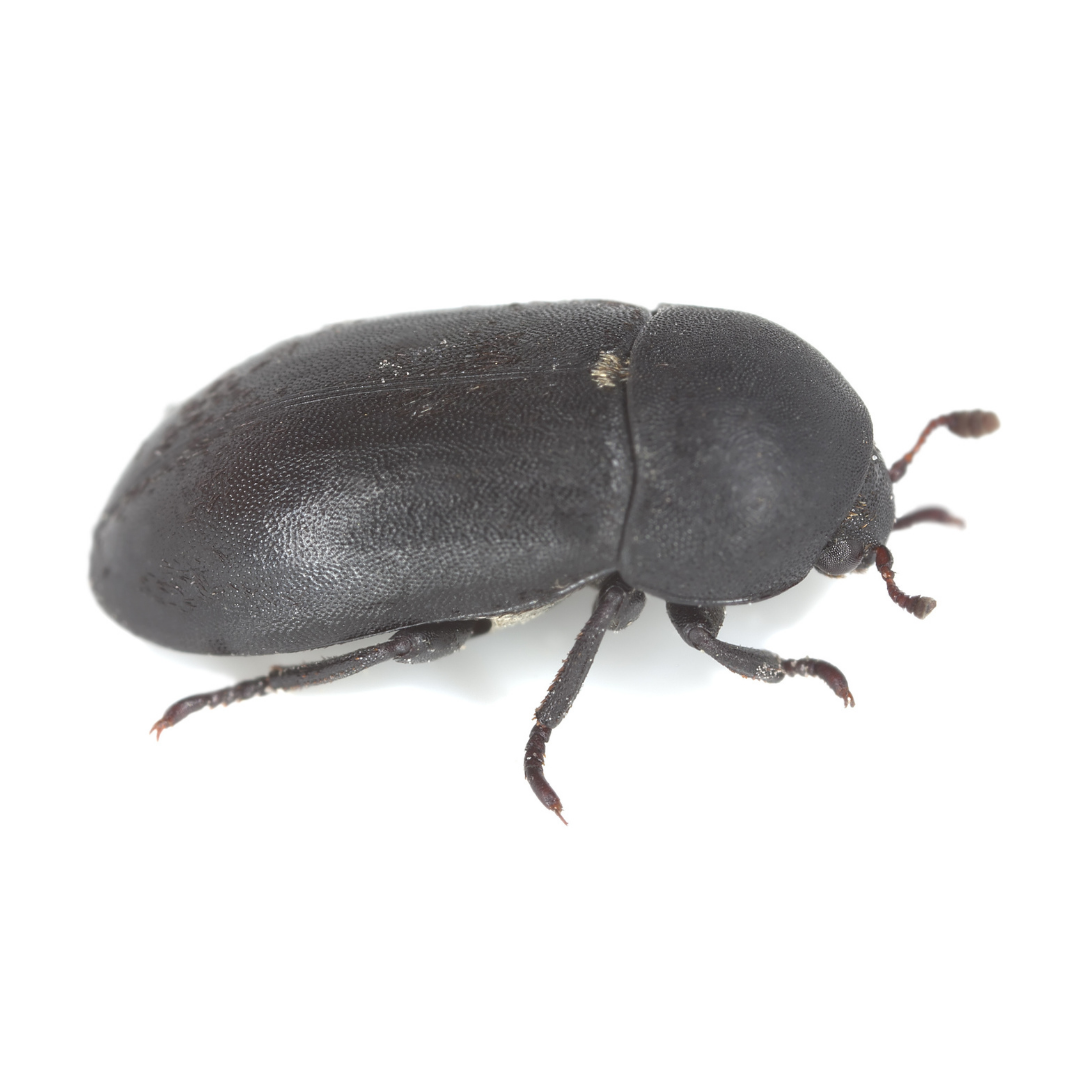Hide Beetle (Dermestes maculatus)


Hide Beetle Traps
Hide Beetle Description
Adult Hide Beetles: Adult hide beetles are about 13 mm (0.5 inches) long, dark brown to black and have whitish markings on the shoulders of the pronotum and underside. This species is characterized by the small spike-like points at the tip of the elytra.
Hide Beetle Eggs: Hide beetle eggs are oval and approx. 1.5 mm (0.06 inches) long.
Hide Beetle Larvae: Hide beetle larvae are hairy brown to blackish blue in color and about 13-19 mm (0.05-0.75 inches) long. There is a pair of stiff spines that arise from the second to last abdominal segment. These spines curve upwards.
Hide Beetle Pupae: Pupae are slightly smaller than the larvae, and oval in shape. The pupating insect will use its last larval skin to provide a protective covering for the pupa. The end of the pupal chamber may be closed with debris or material the larvae was previously feeding on.
Hide Beetle Life Cycle
The female hide beetle will lay 650-850 eggs in its 60-90-day life span as an adult. Larvae will feed on high protein material such as dried meats, pet foods and skins of animals. The hide beetle life cycle on average takes 44-70 days depending on humidity, temperature, and quality of food.
Hide beetles are less active in colder months and will remain as larvae during this time. This stage can be as short as 35 days or 238 days depending on when temperatures begin to rise. Pupation is a relatively short 7 days.
The adult hide beetle can fly, and peak adult activity occurs in the warmer months with flights occurring until temperatures drop. Several generations can occur during the year.
Hide Beetle Facts
Hide Beetles are commonly confused with other Dermestid beetles.
Other common names for the hide beetle include leather beetle, skin beetle, tallow dermestid, fox beetle, prickly carpet beetle, spotted carpet beetle, and thorny bacon beetle
Hide beetle initiate flight at temperatures above 20°C (68°F).
Hide Beetle Damage & Detection
The hide beetle is often found on dried meat products such as pet food and is most often discovered as a hairy larva in the bottom of pet food bags. These larvae can burrow into paper, cardboard, Styrofoam insulation and wood, leaving a round hole approximately 6mm (0.25”) in diameter.
Cast skins are numerous in heavily infested materials. Adults are frequently found perched on the top of infested material or hiding in crevices of bones and cracks with food debris.
Hide Beetle Monitoring Tips & Tricks
Hide Beetle Monitoring Guidelines
Lure
The small cellulose lure contains both an aggregation pheromone blend for the hide beetle as well as food attractants. Adults and larvae will be attracted to these lures.
Lure Storage
Keep unopened foil pouches in cool storage less than 16°C (60°F) or place in the freezer for extended storage. Lures can remain frozen for up to 24 months or at room temperature for 12 months to retain their full effectiveness for use afterwards. High heat 35°C (95°F) will degrade the attractants and pheromone.
Trap Designs Used with Lure
FLAT TRAPS are low profile flat rectangular sticky traps that can be placed on level surfaces. These are recommended to capture both adults and larvae.
ALL BEETLE TRAP consists of three parts: A clear lid, blue base, and snap in tray. This device can be paired with many different types of attractants available by Insects Limited depending on the insect you are monitoring. These are recommended to capture both adults and larvae hide beetles.
Hide Beetle Pheromone Traps
Hide Beetle Trap Placement & Use
Trap Placement Techniques
Pheromone traps can be placed year-round but are especially recommended when temperatures exceed 12.5°C (55°F). Floor pheromone traps like the All Beetle Trap and Flat Trap are most effective at capturing hide beetles. In areas such as a pantry or home, place one or two traps per room.
In commercial areas, such as warehouses or retail stores, place pheromone traps 7.5–15 m (25 – 50 feet) apart to determine the presence or absence of hide beetles. Increase pheromone trap density to 4.5–7.5 m (15–25 feet) apart to help locate the source of hide beetles.
Hide beetle pheromone traps are best utilized in areas that store dried meat goods such as food, animal feed, or pet food. Keep pheromone traps 7.5 m (25 feet) away from exterior doors.
Trap and Lure Maintenance
Replace traps when glue is filled with insects or becomes dusty. Replace pheromone lures every 90 days. Replace all pheromone lures in a location at the same time. Do not stagger lure replacement over several weeks. Record date and number of catches to identify trending information.
Hide Beetle FAQs
What do hide beetles look like?
Adult hide beetles are about 13 mm (0.5 inches) long, are dark brown to black and have whitish markings on the shoulders of the pronotum (the plate behind the head) and on the complete ventral side (underside) of the adult. This species is characterized by the small spike-like points at the tip of the elytra (wing covers).
Eggs are oval and approx. 1.5 mm (0.06 inches) long. The larvae are hairy brown to blackish blue in color and about 13-19 mm (0.05-0.75 inches) long. There is a pair of stiff spines that arise from the second to last abdominal segment. These spines curve upwards. Pupae are slightly smaller than the larvae, and oval in shape.
The pupating insect will use its last larval skin to provide a protective covering for the pupa. The end of the pupal chamber may be closed with debris or material the larvae was previously feeding on.
What is the life cycle of hide beetles?
The female beetle will lay 650-850 eggs in its 60-90-day life span as an adult. Larvae will feed on high protein material such as dried meats, pet foods and skins of animals.
The life cycle on average takes 44-70 days depending on humidity, temperature, and quality of food. These beetles are less active in colder months and will remain as larvae during this time. This stage can be as short as 35 days or 238 days depending on when temperatures begin to rise.
Pupation is a relatively short 7 days. The adult can fly, and peak adult activity occurs in the warmer months with flights occurring until temperatures drop. Several generations can occur during the year.
How can I control hide beetle populations?
Once an infestation of hide beetles has become established, the first step in getting rid of hide beetles is to figure out where they are coming from and then removing or treating that object. This is best done using a combination of pheromone and food attractants in a monitoring trap.
Greater numbers of hide beetle adults or larvae in a trap will indicate that you are close to an infestation. The greater the number of hide beetles in the hide beetle trap, the closer you are to the source of the infestation. It eventually comes down to a detailed visual inspection of the area around the traps with the highest activity to find the source.
With hide beetles, it could be taxidermy, pet foods such as pigs ears, or other hide/meat based objects. Once you locate the source of the infestation with hide beetle pheromone traps, it is best to bag it up if it is small enough. Then those infested objects can be safely disposed of in an external trash bin or it can be frozen, such as in these freezer treatment bags for insects for 1 week to kill all stages of the hide beetles.
On large items such as taxidermy, steam cleaning or freezing with nitrogen will kill insects on the surface. Chemical treatments should be avoided, but if it appears as the only option for large objects, then an anoxic treatment, carbon dioxide or gas fumigation may be necessary.
Hide Beetle Pheromone Traps
Join Our Informed Community
Receive the latest industry updates as soon as they are published.







